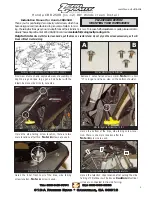
SETTING UP THE HOUSING
PREPARING THE CAMERA
1.
Install a (preferably empty) memory card
battery inside the camera. Note that SDXC Class10 or UHS
required for high frame rate recording with the RX100 IV
2.
Remove the camera strap from the camera if one was installed.
3.
Turn the Mode Dial so the Auto (green symbol) shooting mode is selected and aligned with the
white mark on the left of the wheel. This will allow for the camera and housing mode dials to be
aligned, so the housing mode dial
4.
It is recommended to program the camera to the most frequently used underwater photo mode,
lighting and other key settings prior to installing the camera in the housing.
PREPARING THE HOUSING
1.
When using the housing for the first time
a.
Peel the transparent plastic
b.
Install the hand lanyard
bottom right of the housing (fa
in order to make sure it is secure
c.
Install the housing side of t
upper rectangular loop
Plate secure string is attached to
that this line may come assembled and then there is no need for installation.
d.
If making use of the Hybrid Vacuum Safety System, install the vacuum valve on the
housing. Please refer to the “Hybrid Vacuum Safety System” section for instructions.
e.
Open the housing (see section
System”) and remove the anti
Note
It is important that
empty (no camera installed inside)
watertight seal
periods of storage.
FRX100 VA R Housing Instruction Manual
13
UP THE HOUSING
memory card (16 GB+ capacity recommended) and a fully charged
Note that SDXC Class10 or UHS-I compatible memory cards ar
required for high frame rate recording with the RX100 IV and RX100 V.
rom the camera if one was installed.
Turn the Mode Dial so the Auto (green symbol) shooting mode is selected and aligned with the
e wheel. This will allow for the camera and housing mode dials to be
housing mode dial will indicate the proper mode selected by the camera
It is recommended to program the camera to the most frequently used underwater photo mode,
hting and other key settings prior to installing the camera in the housing.
When using the housing for the first time-
transparent plastic screen protector off the back door exterior
Install the hand lanyard on the housing by inserting it through the lanyard loop on the
bottom right of the housing (facing from back), then pulling it through itself and test
to make sure it is secure (image #1 on the following page).
Install the housing side of the diffuser quick release secure line by tying it around the
upper rectangular loop at the top left side of the housing, where the Fiber Optic Cable
Plate secure string is attached to as well (image #2 on the following page
come assembled and then there is no need for installation.
If making use of the Hybrid Vacuum Safety System, install the vacuum valve on the
housing. Please refer to the “Hybrid Vacuum Safety System” section for instructions.
Open the housing (see section “Opening the Housing” and “Hybrid Vacuum Safety
and remove the anti-glare hood out of the housing. Secure the anti
It is important that a first dive is always carried out with the housing
empty (no camera installed inside) in order to verify that the housing
watertight seal has not been affected during transport and
periods of storage.
Instruction Manual 20200225
and a fully charged
I compatible memory cards are
Turn the Mode Dial so the Auto (green symbol) shooting mode is selected and aligned with the
e wheel. This will allow for the camera and housing mode dials to be
indicate the proper mode selected by the camera dial.
It is recommended to program the camera to the most frequently used underwater photo mode,
door exterior of the housing.
inserting it through the lanyard loop on the
it through itself and testing it
by tying it around the
left side of the housing, where the Fiber Optic Cable
on the following page). Please note
come assembled and then there is no need for installation.
If making use of the Hybrid Vacuum Safety System, install the vacuum valve on the
housing. Please refer to the “Hybrid Vacuum Safety System” section for instructions.
and “Hybrid Vacuum Safety
Secure the anti-glare hood
carried out with the housing
in order to verify that the housing
ed during transport and after long














































